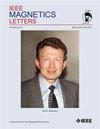表面自旋与表面声波的磁弹性耦合
IF 1.1
4区 物理与天体物理
Q4 ENGINEERING, ELECTRICAL & ELECTRONIC
引用次数: 0
摘要
通过与表面自旋波的磁弹性耦合,可以实现表面声波的非互易传播。在此,我们从理论上研究了钇铁石榴石(YIG)/钆镓石榴石(GGG)双层中以与波传播方向倾斜的角度在平面内磁化的SAW-SSW耦合。推导了考虑两波实际厚度分布的耦合率表达式。SAW - SSW耦合的影响在SAW和SSW光谱的交叉点最为明显,对于典型的实验参数,这个交叉点发生在大约2 GHz的频率和2µm的波长。在此条件下,位于YIG层自由表面附近的ssw的耦合率对系统参数的依赖性较弱,且超过25 MHz。相反,当SSW定位在YIG/GGG界面附近时,随着YIG厚度的增加,耦合速率迅速降低,并且在厚度大于0.5µm时,耦合表现出强烈的非互易性。当YIG厚度增加到2.5µm以上时,SAW与高阶驻自旋波的耦合变得重要,这会污染混合磁弹性波的频谱,使SAW - ssw非互易耦合的观测和实际应用变得更加困难。本文章由计算机程序翻译,如有差异,请以英文原文为准。
Magneto-Elastic Coupling of Surface Spin and Surface Acoustic Waves
Nonreciprocal propagation of surface acoustic waves (SAWs) may be achieved through magneto-elastic coupling with surface spin waves (SSWs). Here, we studied theoretically SAW–SSW coupling in yttrium–iron garnet (YIG)/ gadolinium–gallium garnet (GGG) bilayers magnetized in-plane at an oblique angle to the direction of wave propagation. An expression for the coupling rate that considers actual thickness profiles of both waves has been derived. The effects of the SAW–SSW coupling are most pronounced at the crossing point of the SAW and SSW spectra, which, for typical experimental parameters, occurs at a frequency of about 2 GHz and wavelength 2 µm. Under these conditions, the coupling rate for SSWs localized near the free surface of the YIG layer weakly depends on system parameters and exceeds 25 MHz. In contrast, for the opposite direction of wave propagation, when the SSW is localized near the YIG/GGG interface, the coupling rate rapidly decreases with the increase of YIG thickness, and strong nonreciprocity of the coupling is observed for thicknesses over 0.5 µm. With the increase of YIG thickness above 2.5 µm, coupling of SAW to higher order standing spin waves becomes important, which pollutes the spectrum of hybrid magneto-elastic waves, making observation and practical use of nonreciprocal SAW–SSW coupling more difficult.
求助全文
通过发布文献求助,成功后即可免费获取论文全文。
去求助
来源期刊

IEEE Magnetics Letters
PHYSICS, APPLIED-
CiteScore
2.40
自引率
0.00%
发文量
37
期刊介绍:
IEEE Magnetics Letters is a peer-reviewed, archival journal covering the physics and engineering of magnetism, magnetic materials, applied magnetics, design and application of magnetic devices, bio-magnetics, magneto-electronics, and spin electronics. IEEE Magnetics Letters publishes short, scholarly articles of substantial current interest.
IEEE Magnetics Letters is a hybrid Open Access (OA) journal. For a fee, authors have the option making their articles freely available to all, including non-subscribers. OA articles are identified as Open Access.
 求助内容:
求助内容: 应助结果提醒方式:
应助结果提醒方式:


